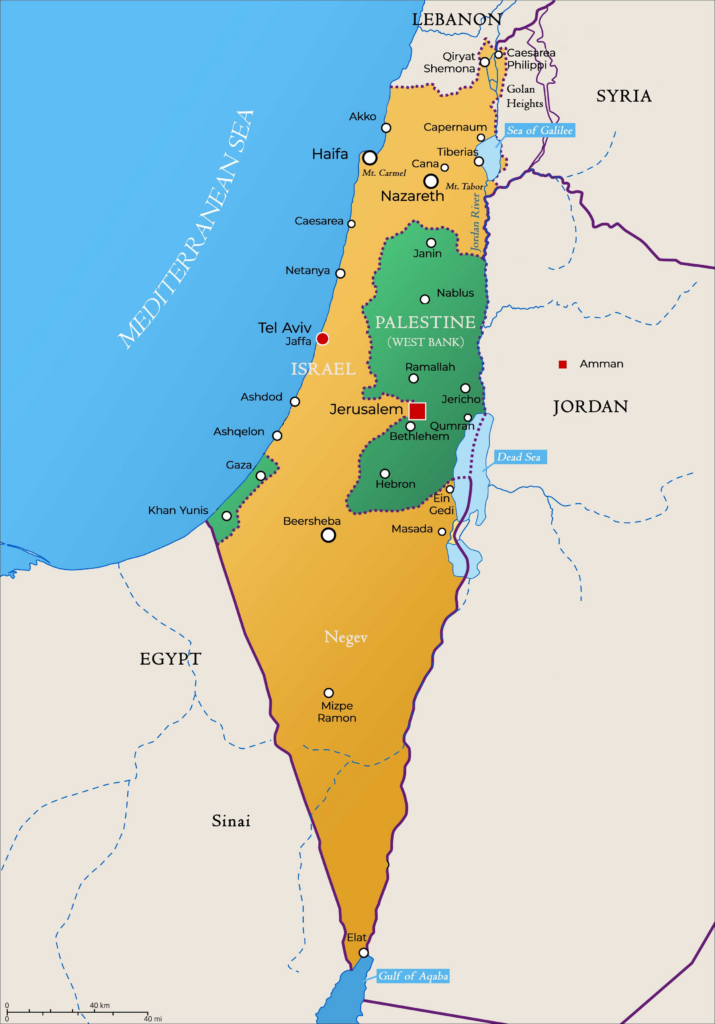Grace Cathedral

Article | December 11, 2023
Swimming in East Jerusalem
Blog|Amy Quirk
Grace Cathedral is publishing this blog, written in June 2023, as part of an ongoing commitment to the humanization of the peoples of Israel and Palestine. Written by congregant Amy Quirk, this account has been edited for clarity, and sensitivity to effects of the Israel-Gaza War. The Holy Land is a small parcel of stunning beauty, unparalleled religious significance, deep pain, and yet, promise. At Grace Cathedral, we pray daily for justice and peace, and for the conditions that make pilgrimage and the exchange of ideas of possible for every child of Abraham.
I swim. It’s what I do. And have done since my parents marched their ducklings to the parish pool. Yet, I prepared to do without in the Holy Land; my aquatic expectations were limited to a dip in the Dead Sea.
Little did I know.
San Francisco’s Grace Cathedral Pilgrimage to the Holy Land was in late May and early June of 2023. The Rev. Mark Stanger skillfully guided us through Jerusalem to the Sea of Galilee, the Jordan River, the Dead Sea, and beyond.
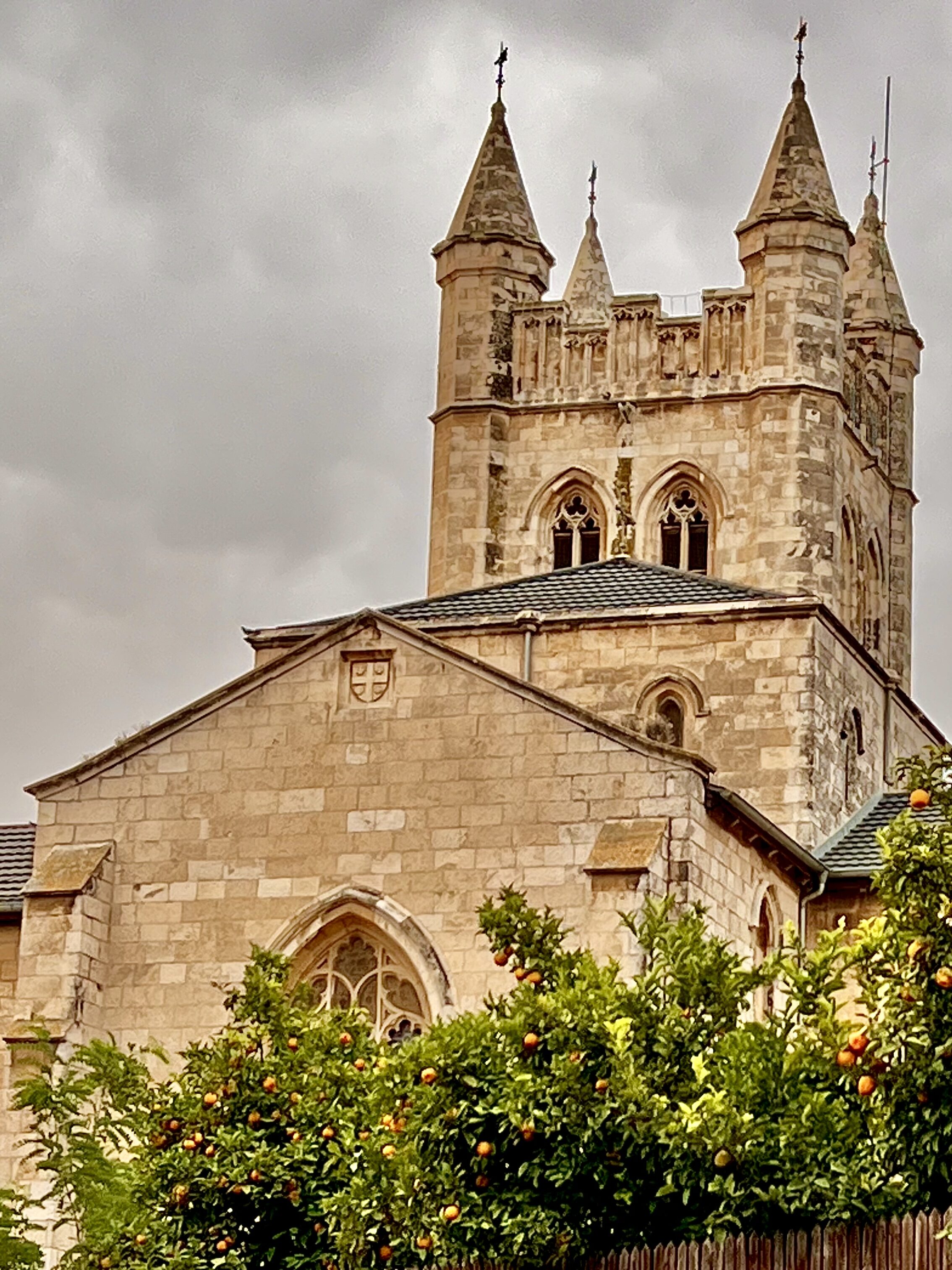
St. George’s Cathedral (Anglican)
Our home base was St. George’s Pilgrim Guest House in East Jerusalem. From there, we ventured forth.
The Natural Environment
The sheer beauty of the natural environment was unexpected. The marbled sky, the varied terrain, and the flowing waters reflected this ancient description:
It is “a good and broad land, a land flowing with milk and honey, ” (cf Exodus 3:8 NRSV)
The sky was splendid by day and awesome by night.
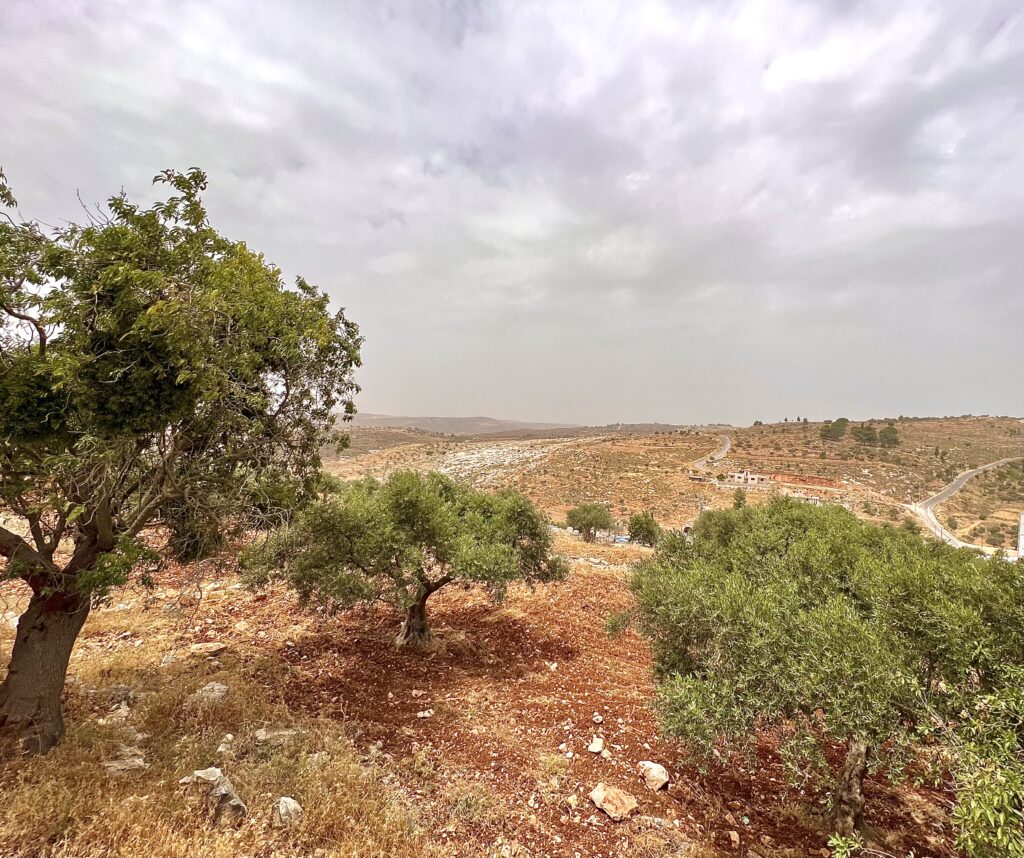
Ramallah District, West Bank

Moonlight over the King David Hotel,
West Jerusalem
The terrain offered not only the anticipated desert, but also lush farmland and mountain peaks.

Early morning in the
Judean Desert
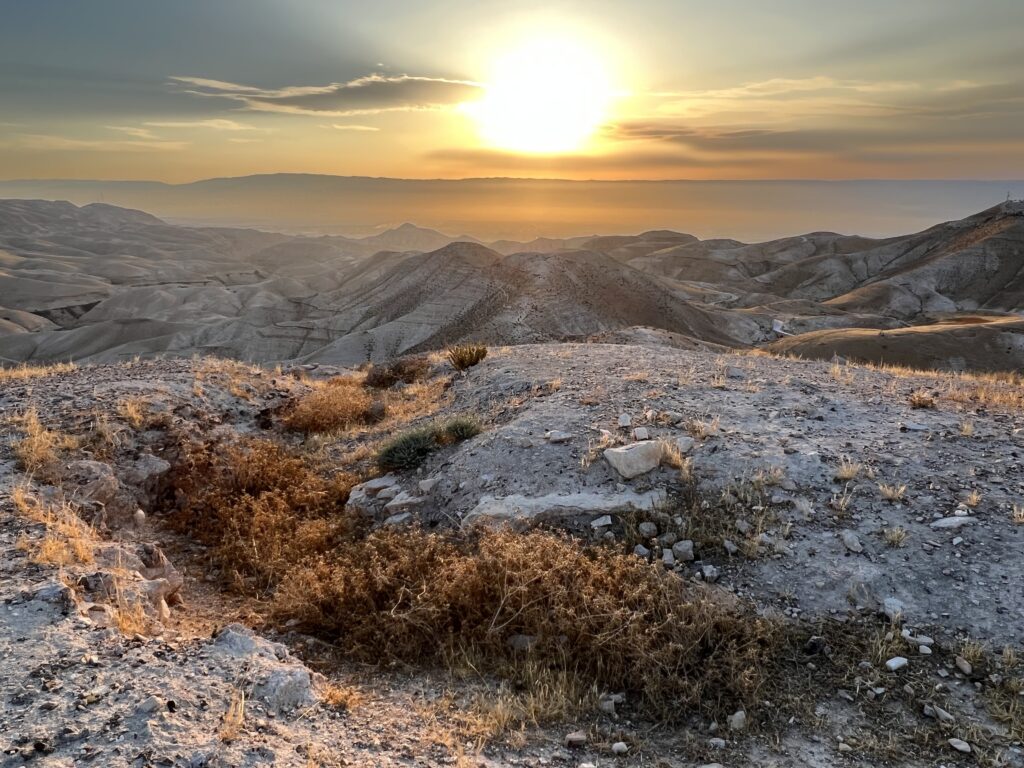
Sunrise over desert mountains
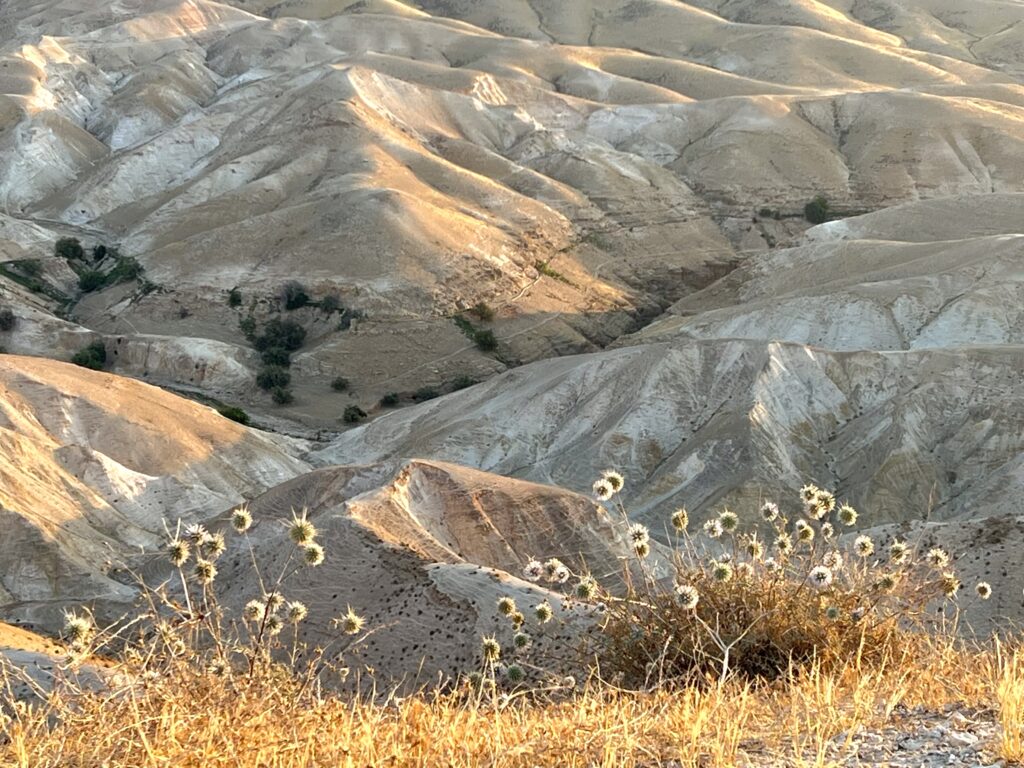
Desert thistle greeting the day
Farms in the Galilee region were thriving on plentiful rainfall and cooler temperatures supportive of crop culture.
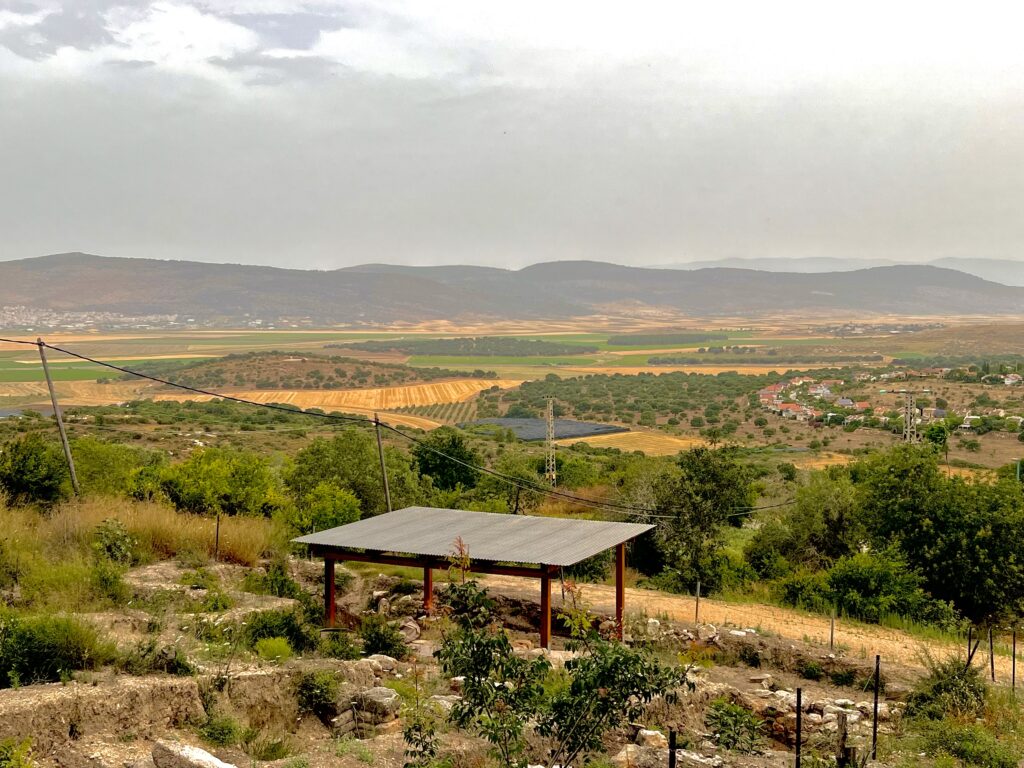
View of fertile Beit Netofa Valley,
in the Galilee region
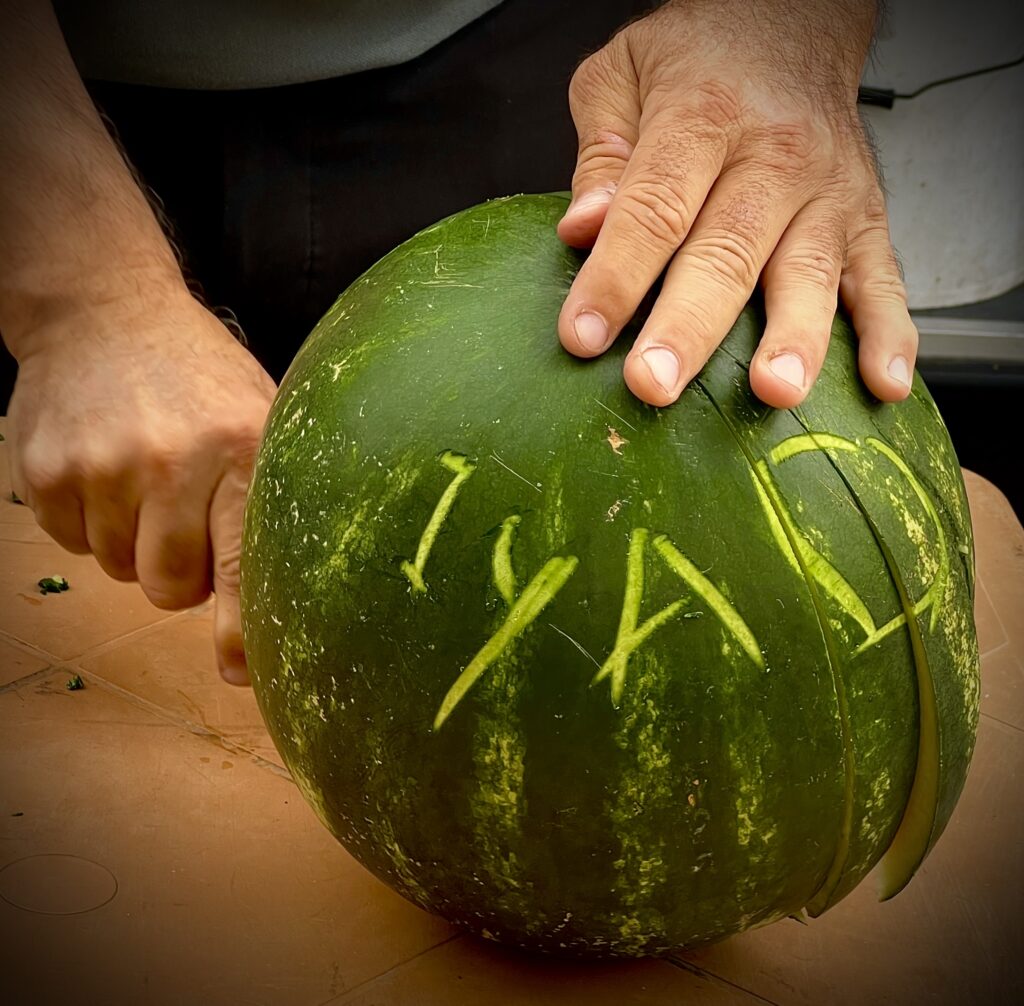
A local treat
The Golan Heights had many cherry orchards tended by the Druze people.
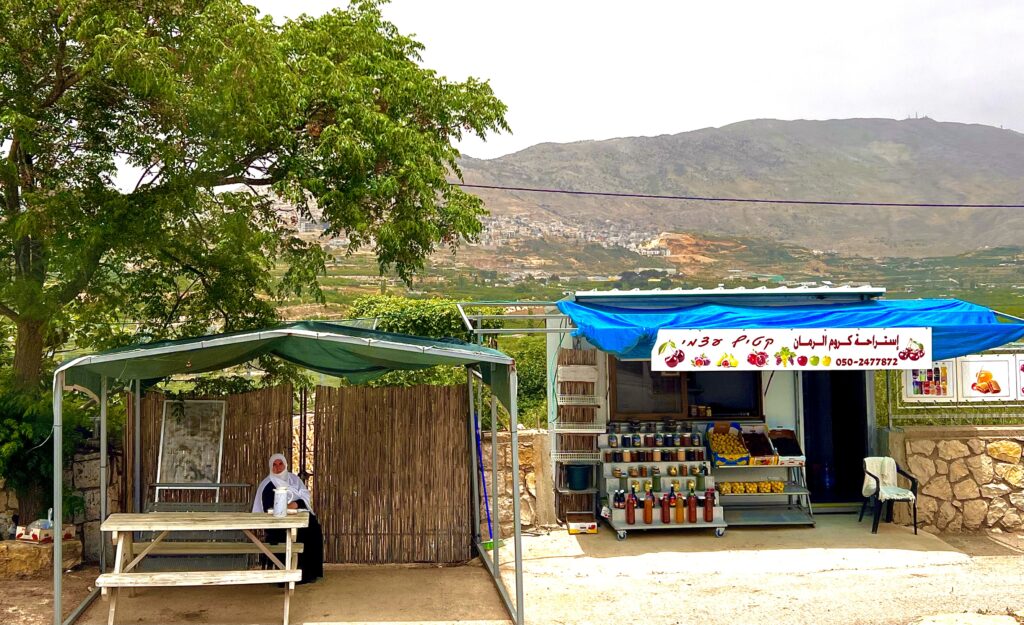
Druze roadside food stand offering
delicious fruit and juices
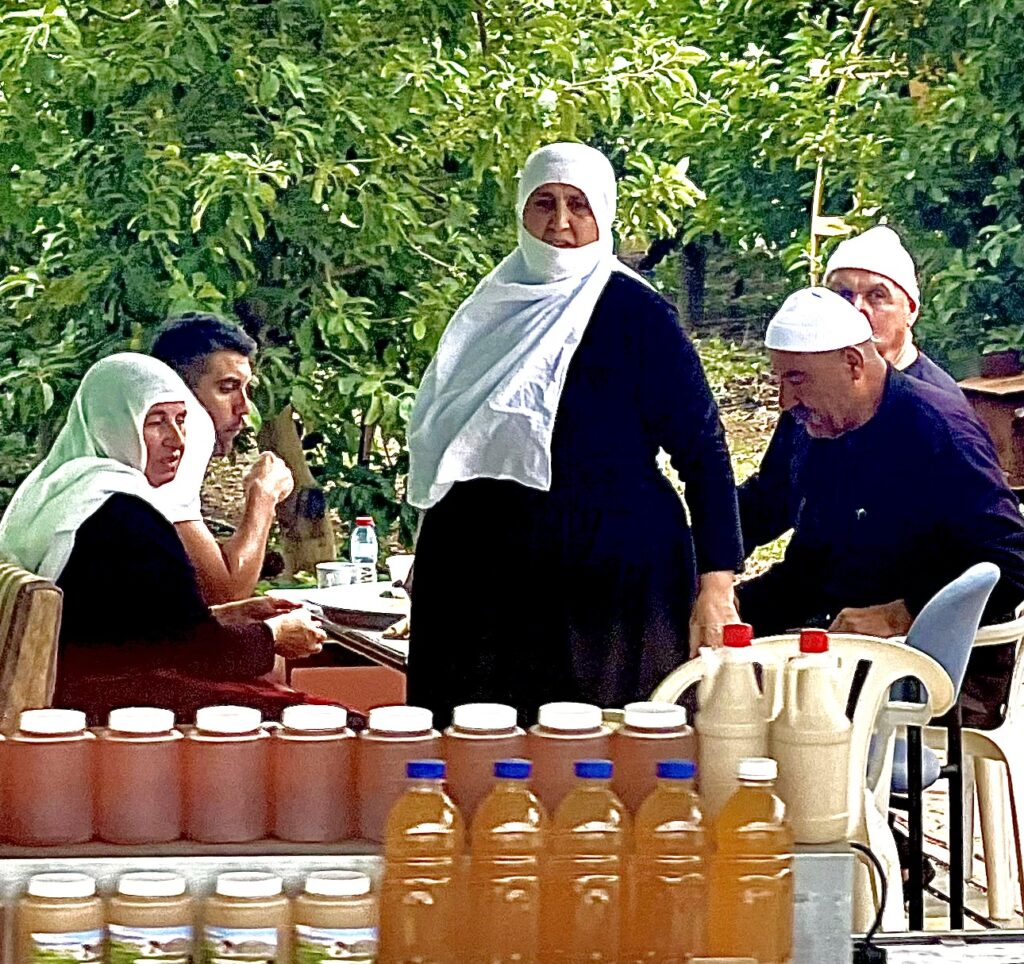
Druze Hospitality
The Holy Land has mountain peaks, such as Nimrod Fortress, overlooking the valley separating Mount Hermon from the rest of the Golan Heights. The fortress is strategically located to monitor the road from Galilee to Damascus, Syria.
Mount Hermon even has a ski resort.
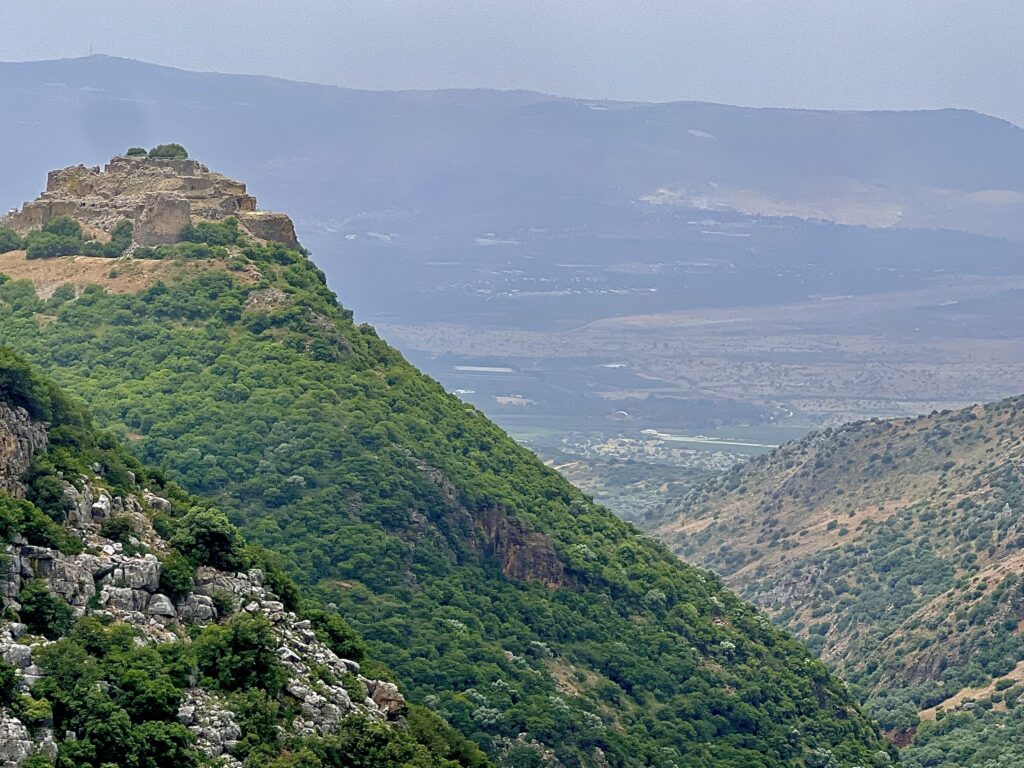
The fortress has guarded against encroaching
armies since Hellenistic times
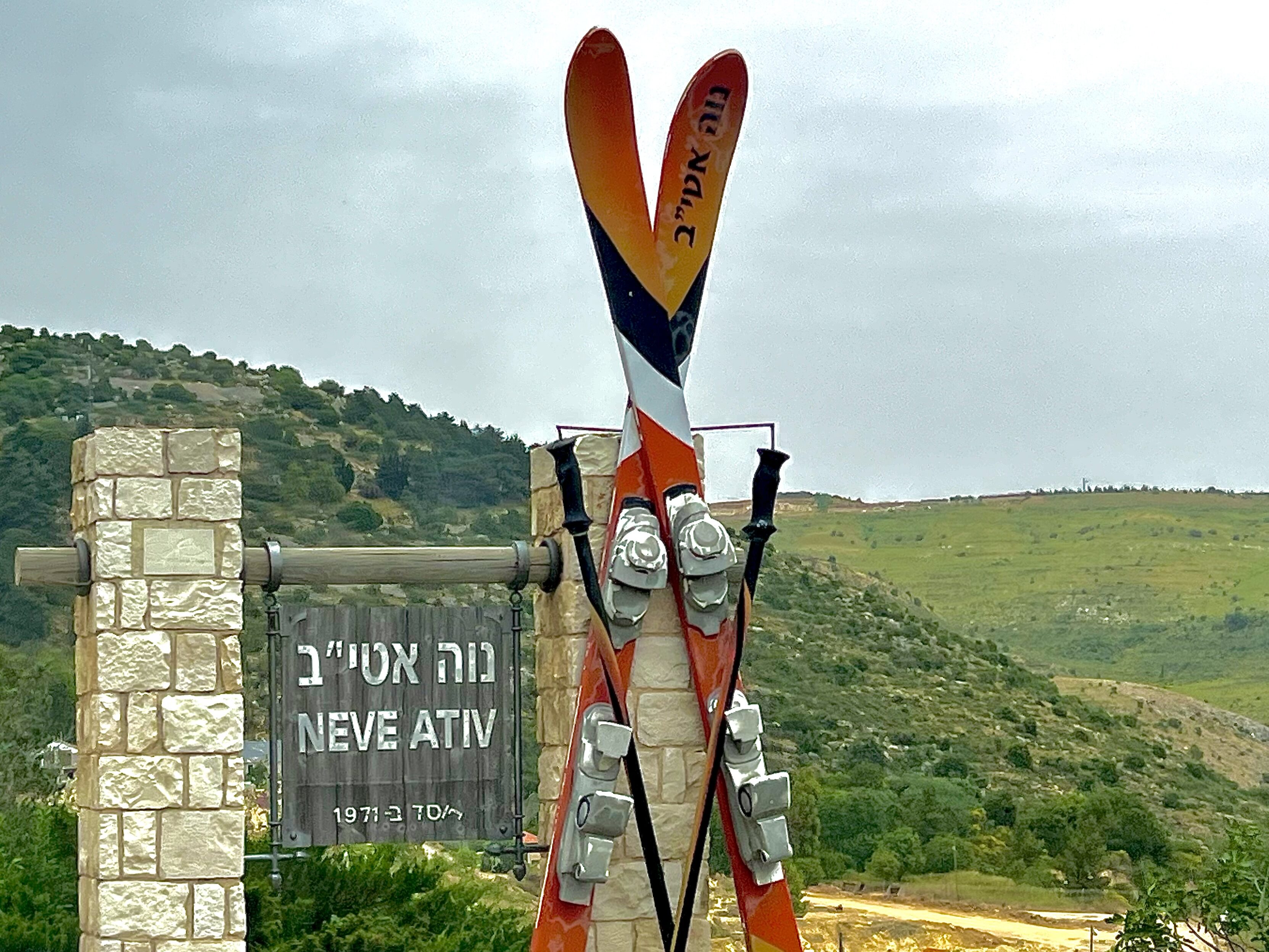
Neve Ativ, surrounded by the Hermon Nature
Reserve in the Golan Heights
And then, there are the flowing waters. Among the most famous are the Sea of Galilee, the Jordan River and the Dead Sea, where I did swim.
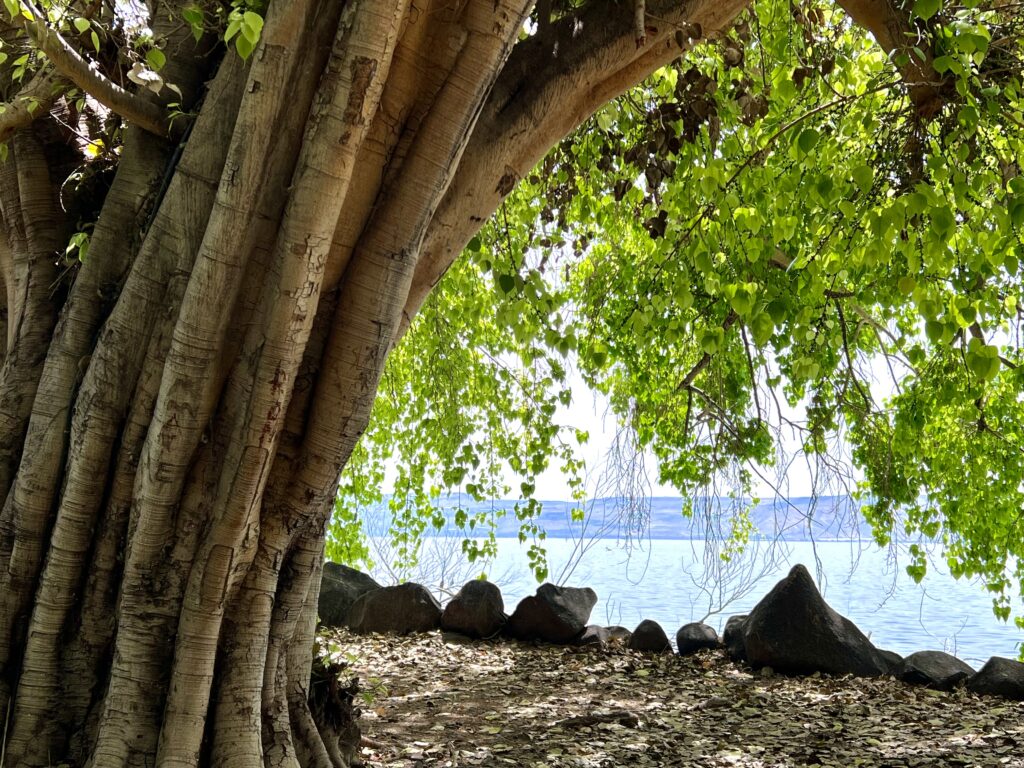
The Sea of Galilee from Tabgha
Pilgrims’ House grounds
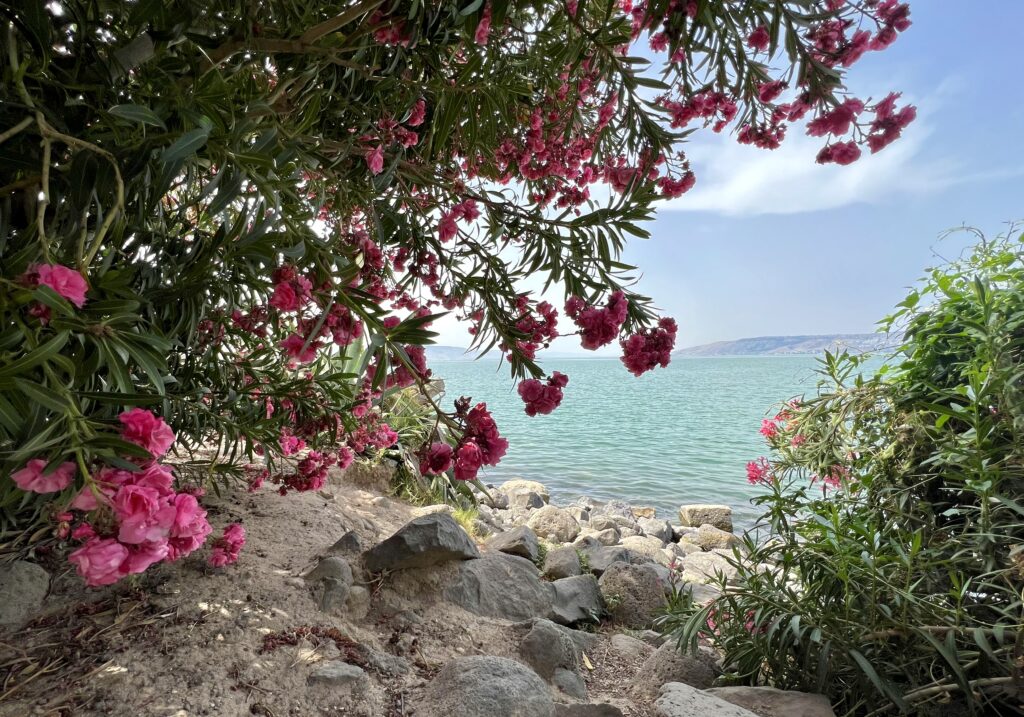
The Sea of Galilee
from Capernaum
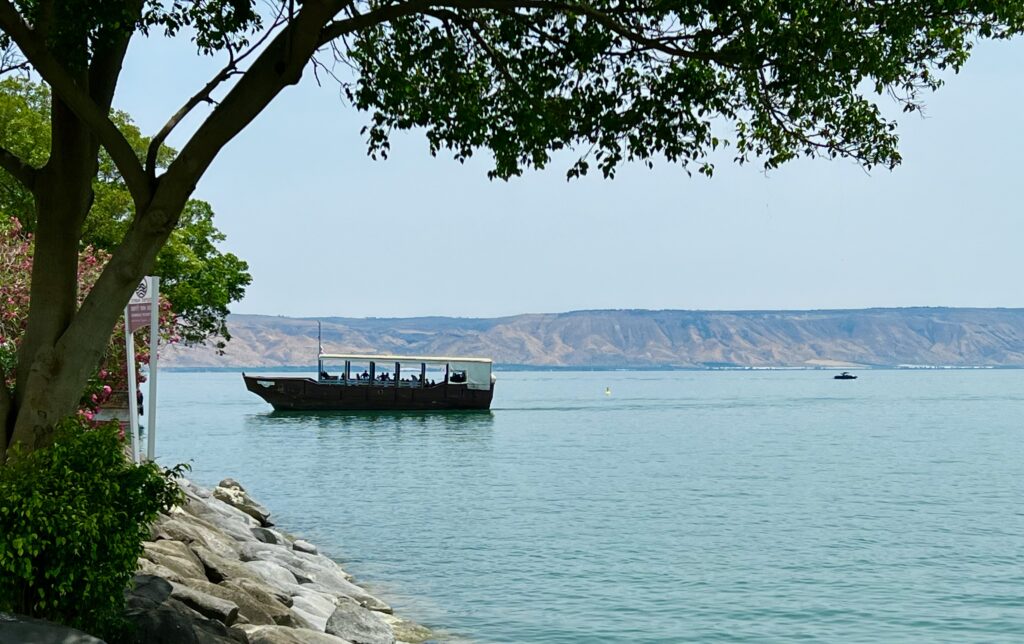
A cruise on the Sea of Galilee
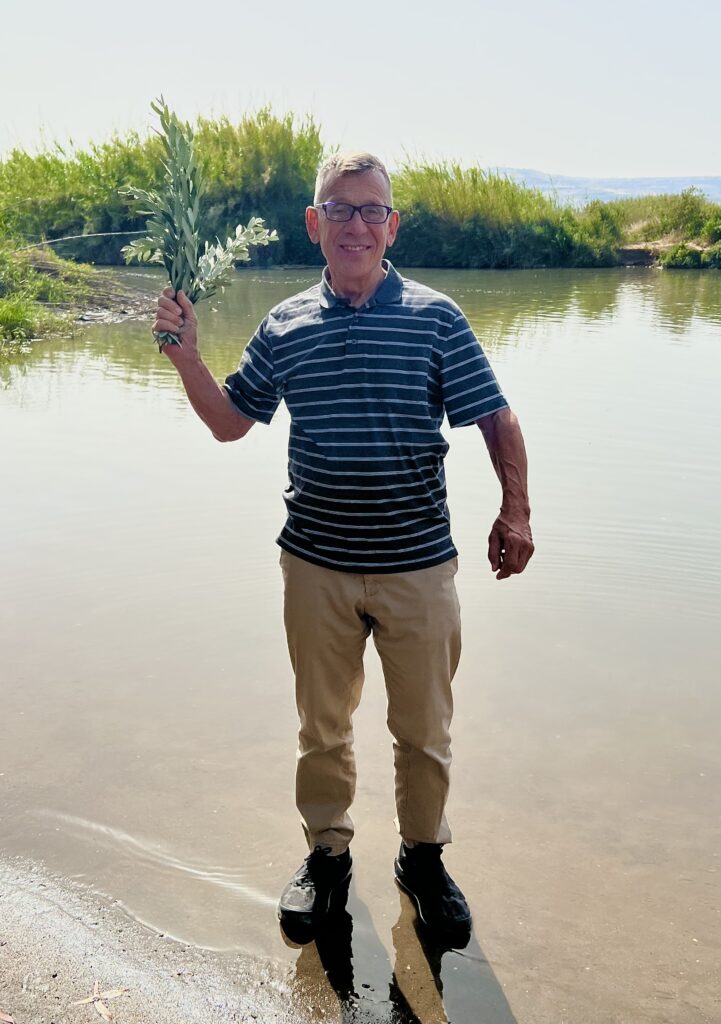
The Rev. Mark Stanger leads the renewal of baptismal vows at the Jordan River.
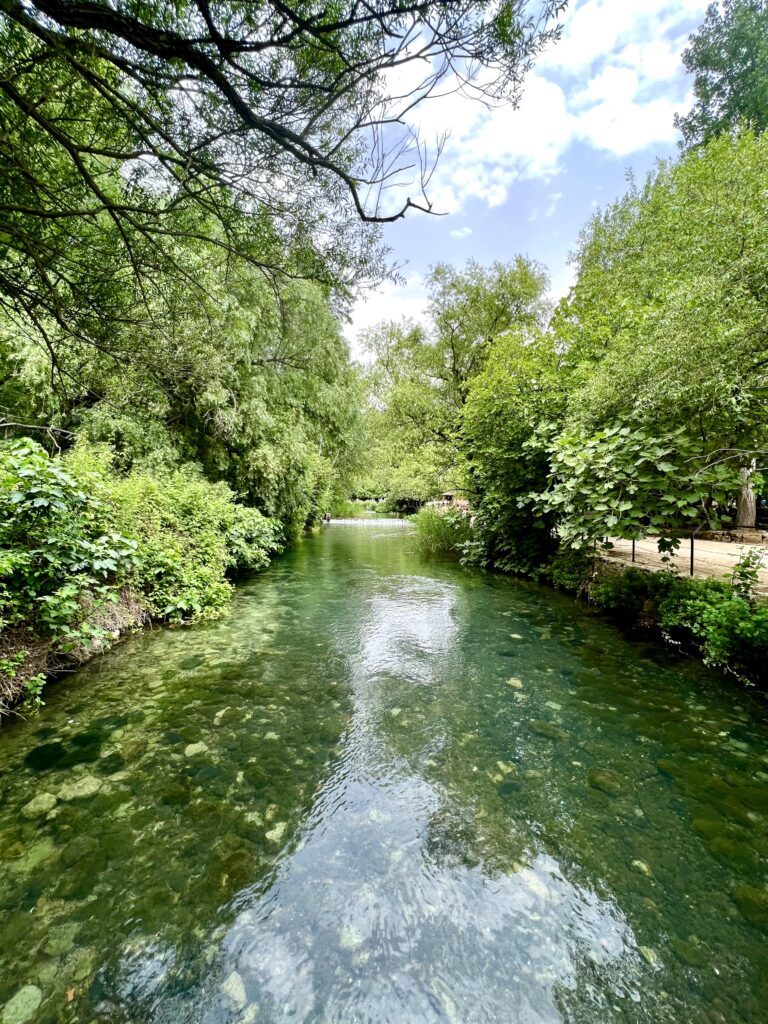
The Banias River, a main tributary of the Jordan River, in a reserve with a natural spring once associated with
the Greek god Pan
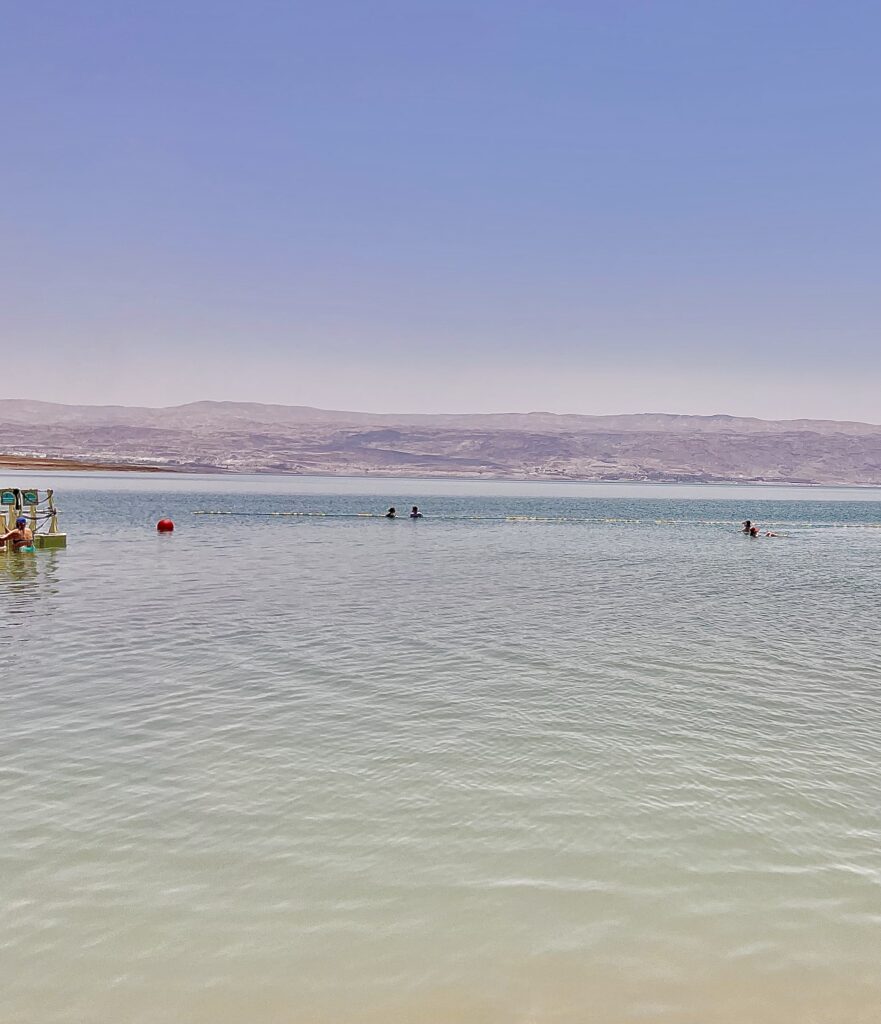
Dead Sea Bathers – The Rev. Ricardo Avila image, edited – I am farther out doing a carefully choreographed backstroke, to avoid the stinging Dead Sea water dripping into my eyes
The Built Environment

The dome above the Edicule, venerated as covering the tomb of Jesus Christ.
The buildings of the Holy Land, particularly within the Old City of Jerusalem, can meet and match the splendor of the natural landscape.
The Church of the Holy Sepulchre is exquisite in its beauty, complexity, and deep religious significance for Christians.
The Dome of the Rock, or Haram Al-Sharif within the Al-Aqsa Mosque compound, glistens above the Temple Mount in Jerusalem.
Another fine example is The Church of All Nations, or “Basilica of the Agony,” next to the Garden of Gethsemane on the Mount of Olives.
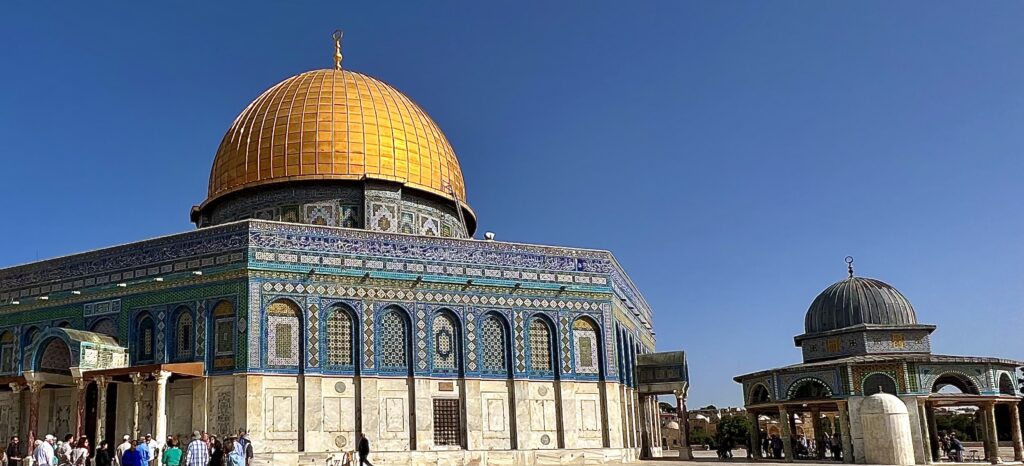
Dome of the Rock and smaller Dome of the Chain, just above the Western Wall of the Temple Mount. The wall is the sole remnant of the Second Jerusalem Temple, built in 516 BCE and destroyed by the Romans in 70 CE. The first temple was destroyed in 586 BCE.
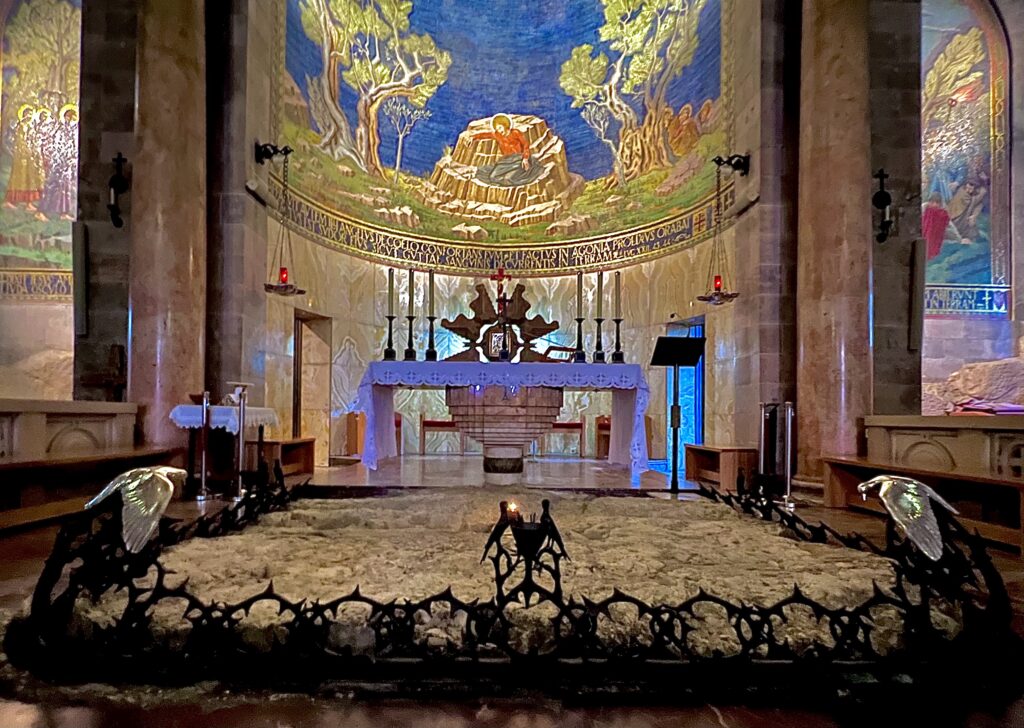
Basilica of the Agony bedrock, where
Jesus may have prayed
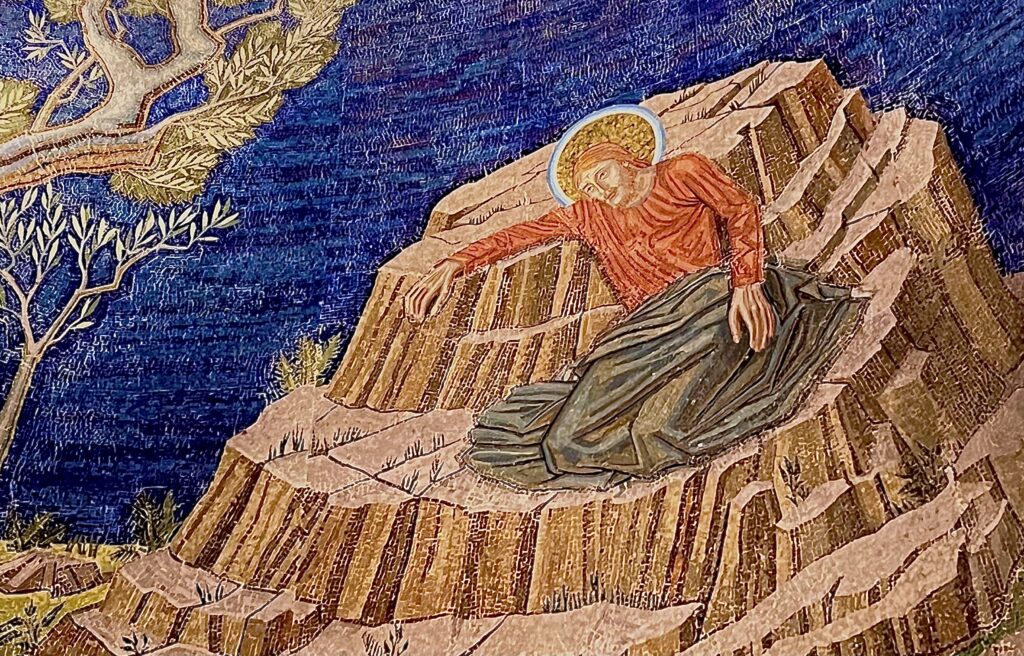
Detail of the Basilica of the Agony apse
So, where might I swim within the built landscape of the Holy Land? Well, in my imagination, here. See the gleaming blue and golden tiles behind the altar?
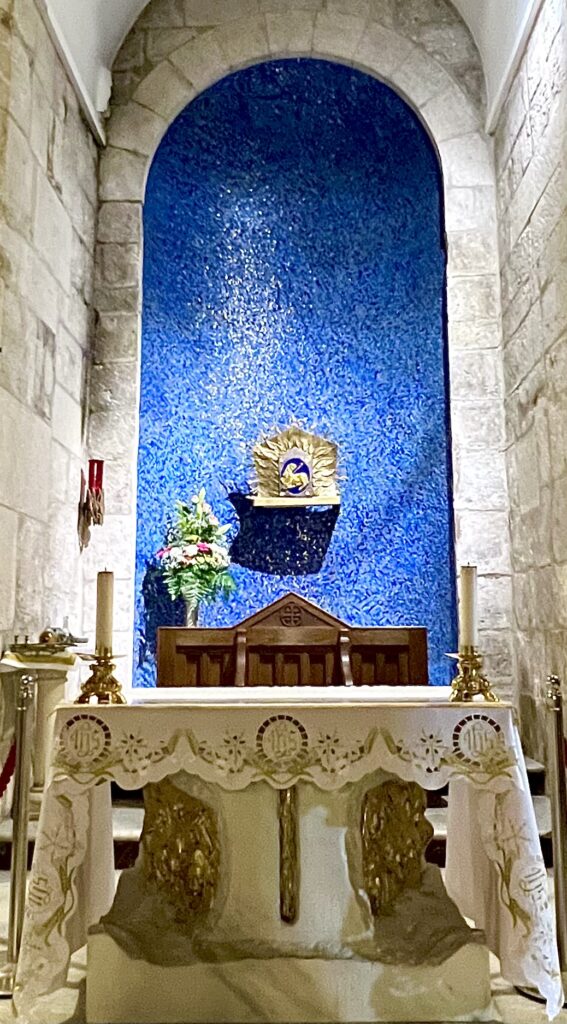
The Chapel of the Apparition, or “Latin Chapel,”
within the Church of the Holy Sepulchre
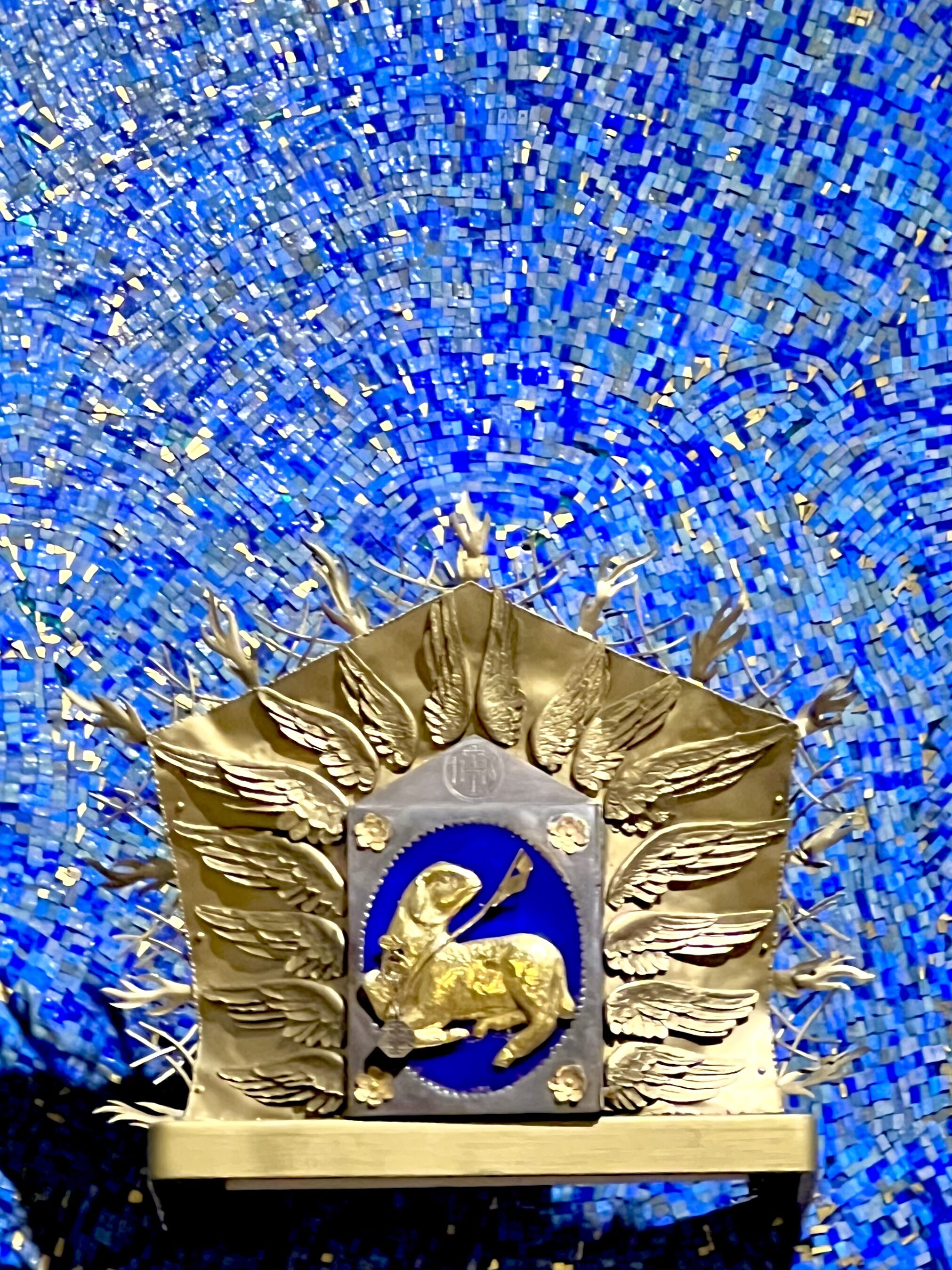
One can imagine being immersed
in a deep blue sea
I found another aquatic palette of sea green and blue amidst glints of sunlight, within the Roman Catholic Basilica of the Annunciation in Nazareth. Our pilgrims breezed through the church late one day, after our travels north from Jerusalem. I immediately felt at ease within the basilica, so resolved to return.
Two days later, I did. Alone. I was on my own, except for a small group celebrating a Spanish language mass way up, around the altar. For nearly two hours, I studied the many portraits of Mary. Each massive image was a gift from a nation seeking to depict the Holy Mother through their own cultural lens. The basilica was awash with the sacred feminine.
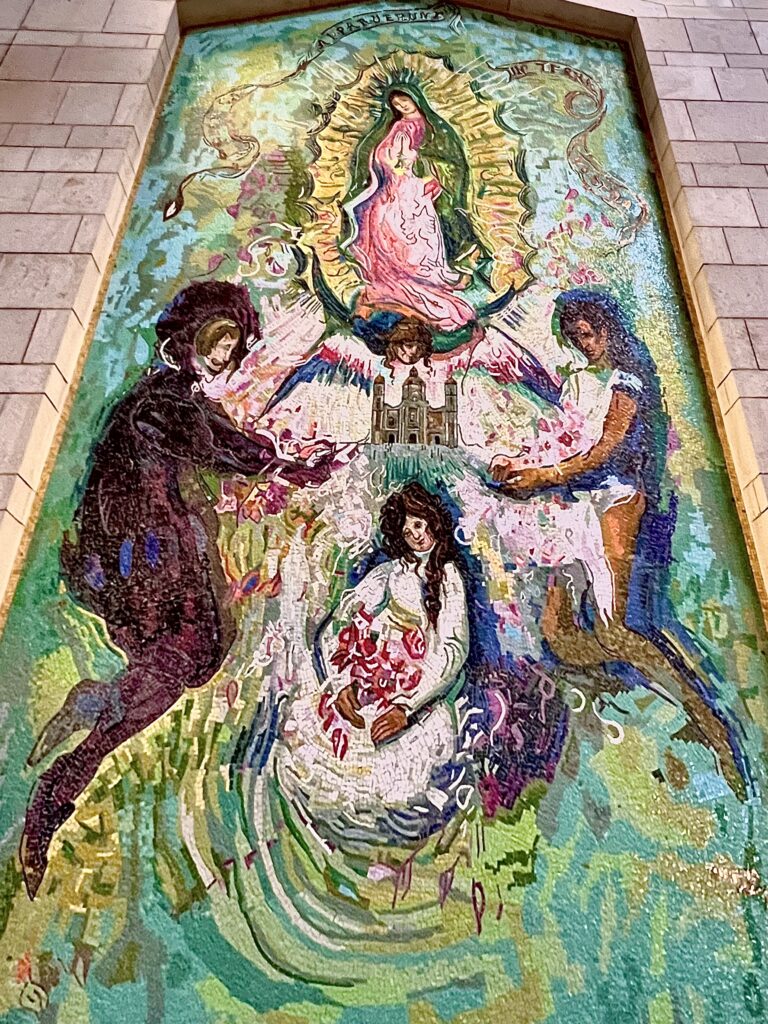
The fluid aqua of Mexico’s Our Lady of Guadalupe
captured my attention.
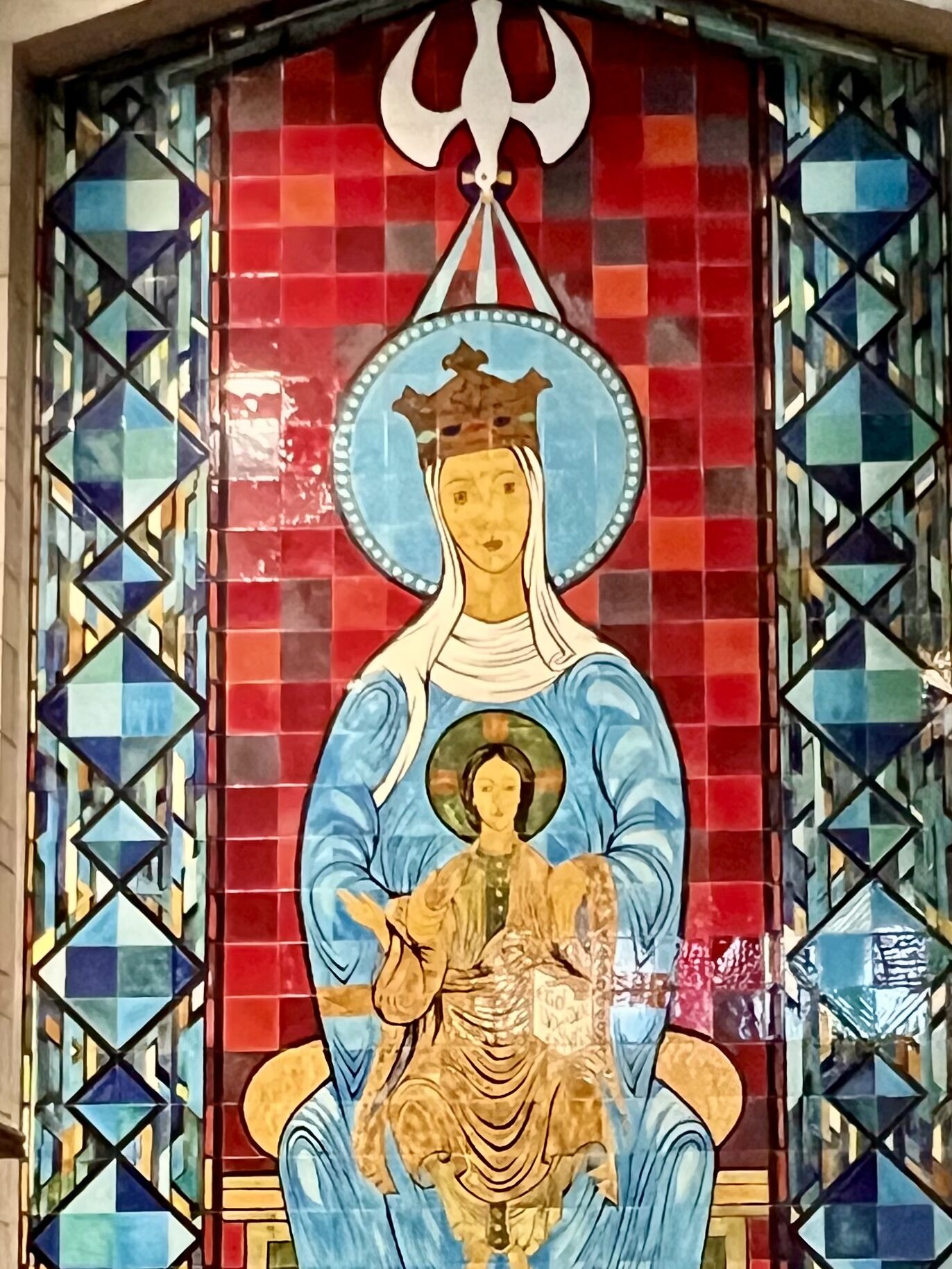
France’s Mary was draped in a blue robe floating
over her body and enfolding the Christ child.
But my reverie stopped, as I stood before the vision of Mary offered by the United States.
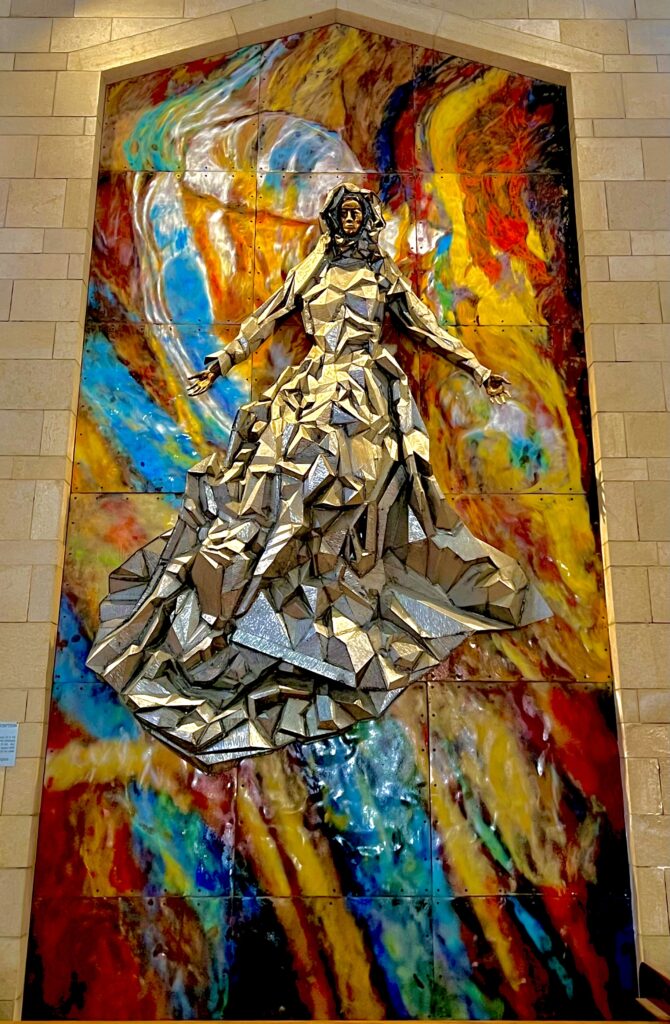
Commissioned in 1972, the monumental bronze, aluminum and glass enamel sculpture is of Mary’s Ascension to Heaven.
The gunmetal gray of Mary’s robes and the conflagration behind her are reminiscent of strife, of war. In 1972, when the piece was commissioned, foreign involvement in the Vietnam war was subsiding. I wonder whether the sculptor drew upon American fatigue with war and the damage it caused, when he created this piece. Mary’s face and hands were mature, her expression sorrowful yet resolute.
The piece triggered memories of my family’s history with gunmetal gray. A great-grandfather was an engineer who came to America while still a “subject of Queen Victoria.” He entered the American Civil War by employing his engineering skills at the Springfield Armory, where innovative weaponry was designed, tested, and manufactured for use by the Union Army.
And, of course, my next thoughts were about conflict in the precious Holy Land, which holds such an abundance of natural and created beauty.
The art moved me. Tears welled up in my eyes and slipped down my face. Rather than try to stop them, I put on sunglasses, turned my face to the wall in the nearly empty basilica and let the water flow. The Rev. Mark had predicted that each pilgrim might have “a moment” and mine was clearly happening now. The questions about why this was occurring and what it meant, were for later. I knew the pilgrimage had just changed, had become more serious for me.
There was an elemental power in the Basilica of the Annunciation that stayed with me. Even through my tears, I felt surrounded and comforted by a presence. This was so within the church and even later at the Sisters of Nazareth Convent where we were staying during this phase of our pilgrimage. I felt grounded, clearer-headed. I knew that what I had come to the Holy Land for, without consciously seeking it, had arrived.
Thankfully, when we returned to Jerusalem, I was able to swim in the East Jerusalem YMCA, across the street from St. George’s. Ladies were admitted from 6:20 to 7 pm, so there was no time to waste! A decent half-mile swim later, I felt renewed. And ready to examine my experience in the Basilica of the Annunciation.
I sought out The Rev. Ricardo Avila, an Episcopal priest who was also on our pilgrimage. We met in a remote section of the garden at St. George’s Pilgrim Guest House and conversed into the night.
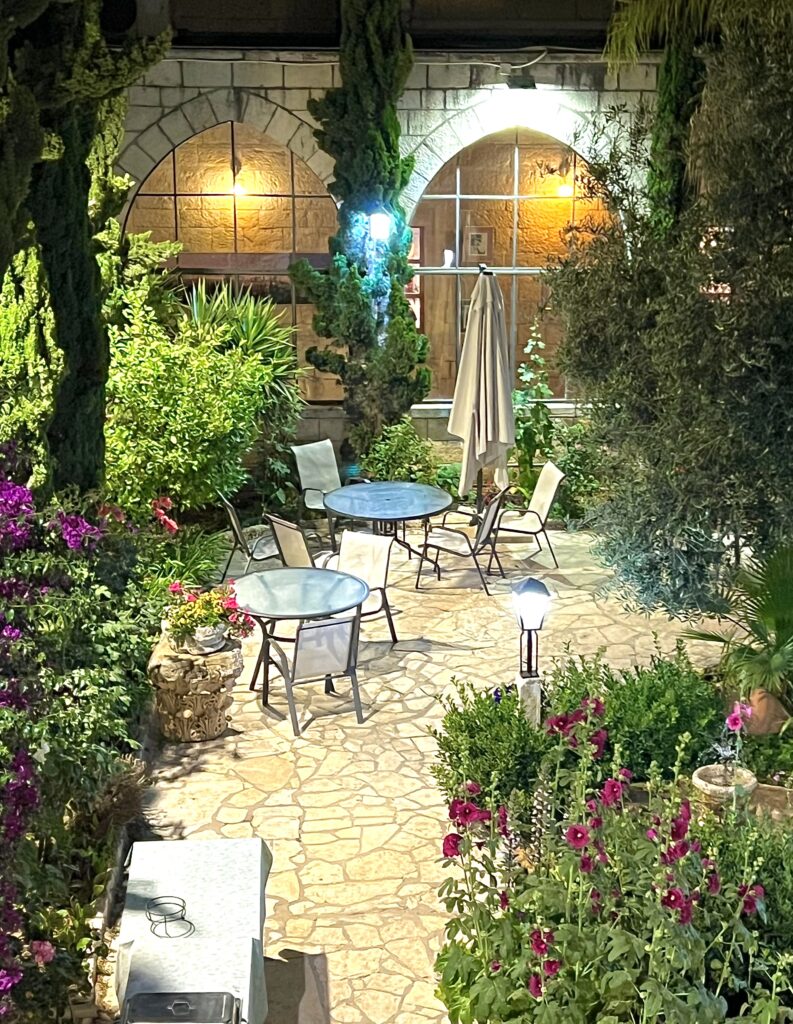
We swam in, around and through my basilica episode to discern its meaning. As I intuited, each of us has had similar experiences in our lives, so Fr. Rico immediately understood the basic questions. As always, the inquiries are whether we have been called to act, to refrain from acting or to simply pause and await wisdom.
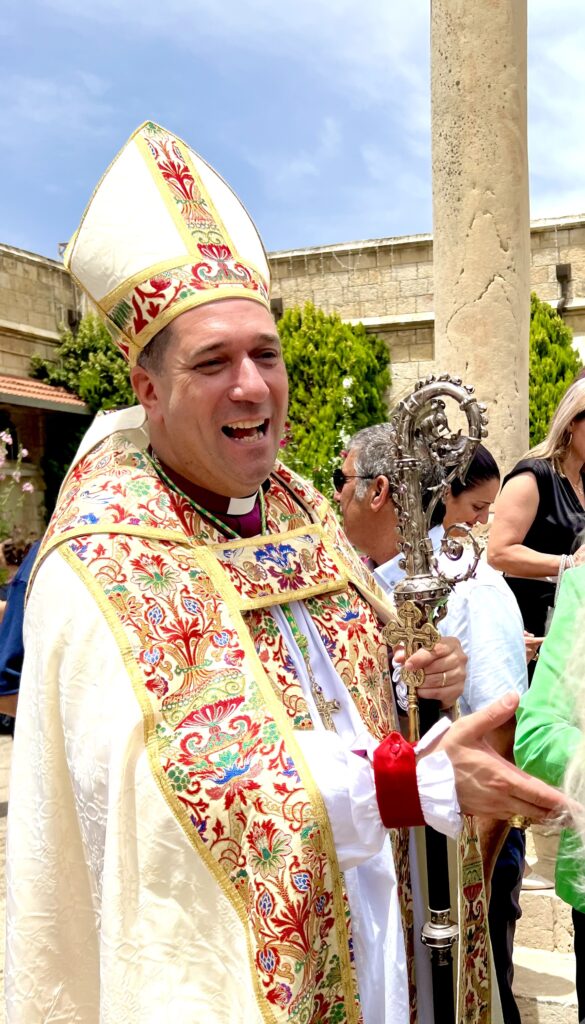
As I continued my discernment through the remaining days of the pilgrimage, I reflected upon the appealing people of the Holy Land.
I met Archbishop Hosam Naoum, a Palestinian, serving as Anglican Episcopal Archbishop in Jerusalem and Primate of the Province of Jerusalem and the Middle East. We initially spoke after the Pentecost service in St. George’s Cathedral.
His Diocese includes 28 parishes spread throughout Israel, Palestine, Jordan, Syria and Lebanon. As Primate, he has additional responsibilities in Cyprus, the Gulf and Iran. While Archbishop Naoum was an undergraduate at Rhodes University in South Africa, he also studied with Archbishop Desmond Tutu. May Archbishop Naoum’s advocacy for peace and reconciliation through a strengthened Christian presence, moderate and mediate the tension in the region.
I saw evidence of the challenges he faces.

Extensive, expressive graffiti on the West Bank Barrier, seperating Bethlehem from the rest of Israel
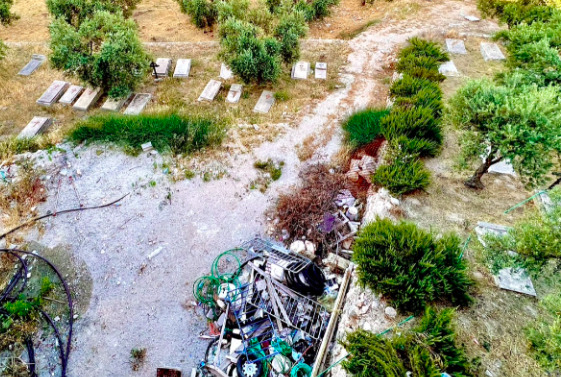
Trash, including discarded security gates, hoses, wood, metal and cement fragments and more, tucked into a corner of a Christian cemetery steps away from the sacred Garden of Gethsemane.
I also met Mahmoud Muna, the esteemed owner of two celebrated bookstores in Jerusalem. One is on the campus of the American Colony Hotel, near St. George’s Guest House in East Jerusalem. When I stopped by, we discussed environmental degredation I had noticed during our pilgrimage, such as the surprising amount of waste I saw strewn in the West Bank and even in East Jerusalem.
The Dead Sea, 1,412 feet below sea level, provides an opportunity to examine how the environment suffers when basic civic services fail.
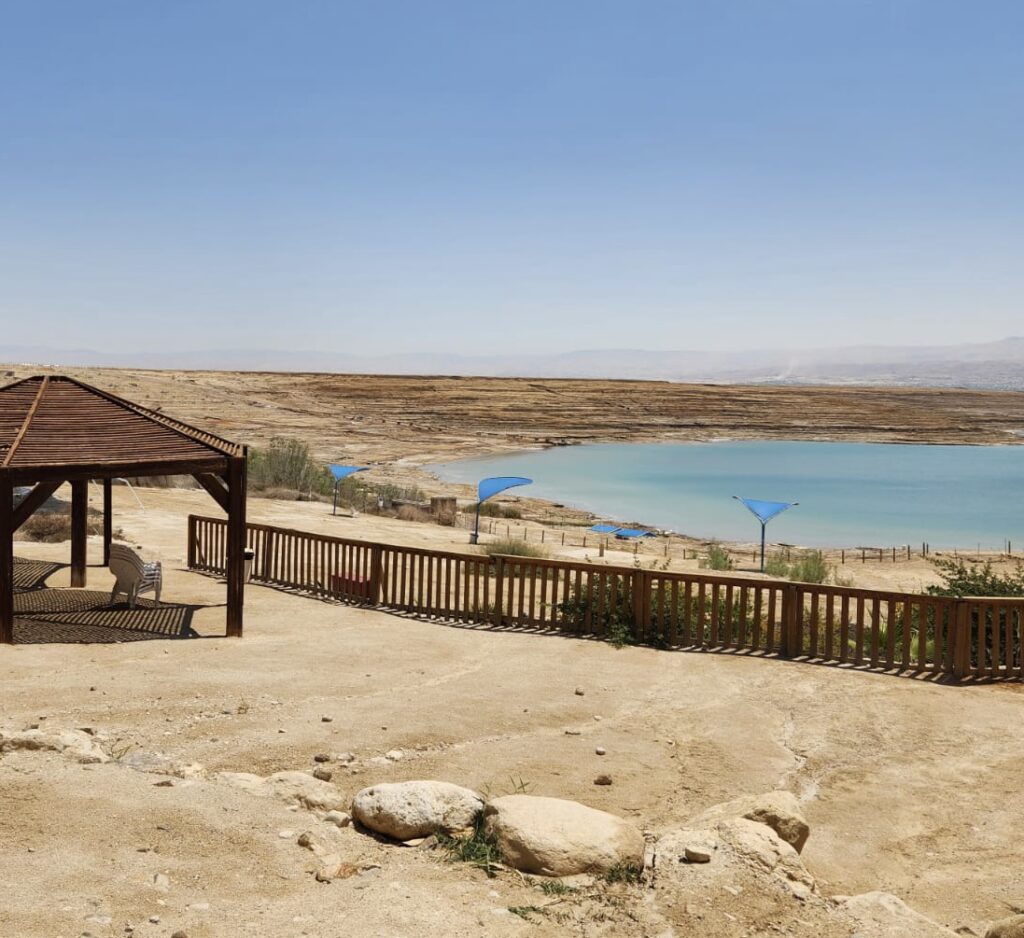
Resort by the receding Dead Sea – Sarah Vestal image, edited
From our conversation and my subsequent reading, I learned about the inequity in waste management and natural resources caused by the occupation. These result in significant damage to the environment in the Palestinian Territories, as well as community health and local economy. Political divisions within the Holy Land impede collaboration in providing basic services. In the end, untreated waste flows from Jerusalem and Bethlehem unimpeded into the Dead Sea.
Mr. Muna also suggested “Nine Quarters of Jerusalem” by Matthew Teller. The apt subtitle is “A New Biography of the Old City.” The book dispels the colonialist notion of dividing Jerusalem’s Old City into merely four quarters. Rather, Teller guides the reader through a more richly nuanced city. An Old City populated with Jews, Christians, and Muslims and descendants of Sufis, Doms, Mamluks, Karaites and many more.
Matthew Teller’s respectful celebration of the ancient diversity of the Holy Land contrasted sharply with this sight as we approached Jerusalem after an excursion.

Wall along Route 60 running north to south, between the West Bank and Israel
I thought again about the caretaker of the Greek Orthodox Burqin Church, the “Church of the Ten Lepers,” in the Palestinian West Bank. Christian tradition is that the healing of the ten lepers, referenced in Luke 17:11-19, took place on the site. I watched the caretaker’s elegant face and hands as he tenderly held an icon he described as being 2,000 years old.
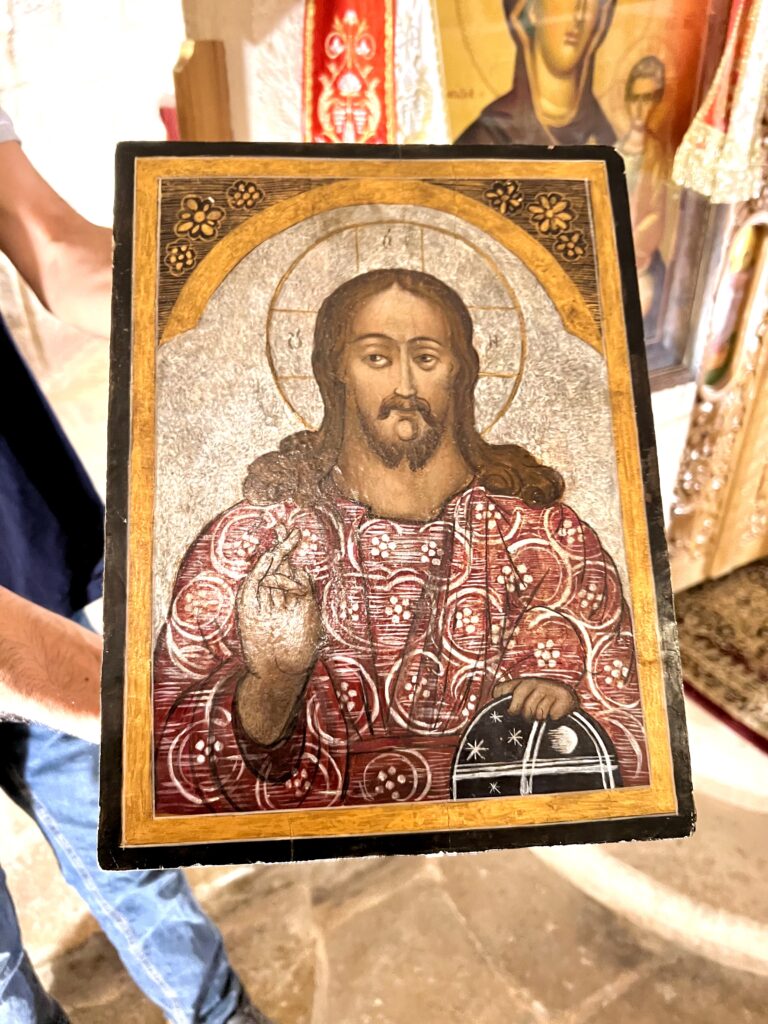
And, I thought of the many Palestinian women I met. The ladies in the YMCA pool from 6:20 to 7 pm were favorites; they welcomed me into the water and into their community. They gave me the gift of truly swimming in East Jerusalem; with each lap of the pool, my head cleared so that I might consider what I had learned during the pilgrimage. By the way, the ladies also gave me a YMCA East Jerusalem swim cap I will treasure.
But I must give one final nod to a tiny nun from the Global South. We encountered each other on my last full day in Jerusalem. She was participating in a Catholic mass within the minute Edicule of the Church of the Holy Sepulchre. Surrounding her was an international group of nuns wearing habits of white, cream, light blue and other pale hues. I was standing outside the Edicule looking in through a carved portal. When the service reached the rite of communion, she turned toward me. Our eyes met for a few beats of the heart, then we smiled and offered each other the international sign of peace. A moment and then it was over. She turned back to her community and I to mine.
My hope is that the tiny nun and I may take what we have learned in the Holy Land and be useful in the world.


